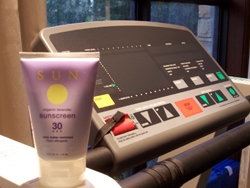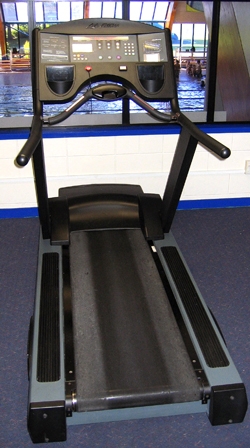Taming the Treadmill
When to Run on a Treadmill
Good Treadmill Workouts
Adjusting to the Treadmill
The Mental Side

In running, as in life, it is good to have options—and for many runners a treadmill is one of the best options available. I have been fortunate enough to have had access to a treadmill and been able to train to the steady hum of the machine and the rhythmic impact of my footsteps on the belt. This time of year, treadmills are especially useful, because they provide a climate-controlled run no matter how cold or snowy or dark it is outside. So, put on your shorts, and suntan lotion if it gets you in the mood, and let’s look at some ways to make your treadmill training as effective and fun as possible.
When to Run on a Treadmill

We all have our own criteria for deciding when to run on a treadmill rather than outside. I love running in the open air in nearly any sort of weather, but still there are times when the treadmill has to be my top choice. I do much of my training in Colorado, and in the spring the wind can be so fierce that it is almost impossible to run normally. And running in a winter snowstorm, while it can be briefly an exhilarating experience, has made the bravest of us choose to turn to the warm indoors for our training. Boulder has had many major storms in past winters, so lots of runners there have been more than happy to train on the treadmills.
You might find the treadmill more appealing than running outside even if a blizzard is not raging. There is nothing wrong with that. It isn’t wise for runners to have boasting contests about who is the toughest and can run outside in the harshest conditions. If you think you will have a more productive or enjoyable workout on the treadmill than running outside, go for it.
There have been times during my marathon training when I have done the second, easier run of the day on the treadmill, especially if I have done a hard workout that morning in the bitter cold. It was so nice to have warmer air to breathe in the afternoon! Similarly, many people with exercise-induced asthma find their symptoms are easily triggered by winter’s cold, dry air and enjoy running inside.
It doesn’t have to be winter for the treadmill to be a good option. Some runners in hot, humid climates like those in Florida or Texas find they can do higher-quality workouts inside.
Often, runners like the precision of the treadmill. They can set it to cover a certain distance in a certain time, or they can program it for a hill or interval workout. I am very much in favor of that, especially if running a treadmill hill program leads to the desire to then venture outside to find a great hill to train on.
Treadmill training can also be a help to beginners embarking on a running program. It is often a comfort to know that if necessary your workout can be halted at any time without having the fear of being too far away from home. Just be sure not to get too reliant on this luxury! As you would outside, it is usually a good idea to try to meet your goal for the day unless there is a worthy reason to stop.
Another benefit is convenience. If you are lucky enough to own a treadmill it can be nice to roll out of bed in the morning and jump right on it, or to come home after work and not have to worry about running in traffic or in the dark. Busy parents can use the treadmill to get in their runs without having to line up child care. Gym members can stop at their health club after work and enjoy the satisfaction of arriving home with their run already “in the bag.” Again, if the treadmill is going to help you to meet your goals for the day, use it.
Good Treadmill Workouts
I mostly use the treadmill for “regular” runs instead of intense workouts. That usually means an easy 10K or so. I think it is best on these easy treadmill runs to not get caught up in trying to hit a certain pace. Do as you would do outside on a relaxed run, and let your perceived effort guide your pace (especially when you consider that a treadmill’s calibration could be off).
A few times when I was preparing for the Boston Marathon, I had a hard workout on my schedule, and the conditions outside were just too uncooperative. So I did those hard runs on the treadmill. These kinds of tempo efforts are well suited to the treadmill because—unless you want to go flying off the back of the belt!—you can’t let your pace lag as you tire, something you might be tempted to do outside.
I often alter the incline of the belt throughout my run to simulate the rolling hills of my regular outside course. You can often learn the topography of an upcoming race course, and a treadmill provides the perfect opportunity to run the similar terrain if you don’t have access to the actual course. If you live in the flatlands, this may be the only hill workout you can get before something like the Boston Marathon, and it certainly beats running up multilevel parking garages or over bridges!
More intense hill workouts are another good choice on the treadmill. Unlike a hill workout outside, you can make the recovery between hard efforts whatever you like without the pounding of jogging downhill between repeats. Also, if you like downhill running or need to prepare for a hilly race, such as Boston, the treadmill can provide good, controlled conditioning if it has the ability to decline to a downhill setting. (This is a good feature to look for if you are thinking about purchasing a treadmill).
Adjusting to the Treadmill
Like many runners, I find that running on the treadmill feels “faster” than running outside. At a pace that would usually feel nice and relaxed outside, I often feel like I am working harder. If you have this sensation, it is likely that you are taking more steps per minute on the treadmill than at the same pace outside, so your legs feel like they are being “sped up.”
Why is that? I think my running form is a little different on the treadmill. Because the treadmill belt is running underneath me, I don’t need to push off as much with each step. Instead, my foot hits the belt, it is pulled back for a fraction of a second, but then I have to lift it quickly so that I stay on the belt. This quicker lifting of the foot causes the feeling of working harder, when in fact the belt’s movement actually requires you to exert less effort.
I have done a lot of tests to determine the best “baseline” setting, and found that an incline setting of 0.5 percent came closest to simulating outside running on flat terrain, though some runners have told me, they prefer a 1.0 percent incline. To find a most effective baseline, I checked my heart rate at a variety of incline settings for several different paces, and found that my heart rate while on the treadmill at a 0.5 percent incline was most similar to what it would be running outside on level ground.
As mentioned earlier, the “assist” from the moving surface allows less effort at the same pace. In addition you are not having to overcome varying wind resistance as you do when you run outside. This setting counters these events. But do alter the incline throughout a treadmill run to simulate a rolling course outside. I feel that is a better idea than to just set the treadmill incline at one point and leave it there for the entire run—it is more like a “real” run.
Maybe you are a newcomer to working out on a treadmill, so the following will be important for your safety as well as for everyone who is using a treadmill: Before you start, make sure the belt—the tread on which you run—operates smoothly. Step on the belt when the speed is still very slow and you can walk comfortably, then turn up the speed and start running slowly. Now, it is OK to go even faster until you achieve the desired pace for your workout.
Please make sure you allow yourself enough time to adjust to running on the treadmill. If at all possible, I would start with only one or two short runs a week. This way you will help your muscles, tendons, and your running biomechanics adjust to the movement of the belt, and you will avoid injury. Later you may add more runs “on the belt.”
The Mental Side
While there are many runners who love running on the treadmill, others aren’t as enthusiastic. They miss the beauty of nature or the charm of ever-changing scenery. If you are in the latter group, there are ways to become more excited about the treadmill. Start by focusing on the positives—such as today you can be sure that you will not miss your workout. Also, you will get to decide exactly how fast and how far you will run. Bring yourself into a better emotional state by imagining yourself on a favorite course (and maybe even crossing the finish line!), or putting on a video or listening to your favorite music. Enjoy the environment you have created and use it to have as much fun as possible.
When I set my treadmill to simulate the terrain of a familiar and enjoyable outdoor loop, I envision myself being outside running that loop, and then imagine what I would be seeing 10 minutes into it, three miles into it, half an hour into it and so on.
I find music a big help when I am on the treadmill. I love the rhythm and the beat—and I enjoy feeling in sync with the music while it helps me to find an ideal running rhythm on the belt. It makes it fun! I will put on a favorite CD, one that I know well, and then count down the songs. “Okay,” I tell myself, “there are two more songs left, and I love both of those songs. No problem!” You might also enjoy watching television—sometimes I watch the Weather Channel to see just how bitter and blustery the weather is I am avoiding—or a comedy or a video about running :).
A great way to make a treadmill run fun is to work out alongside a friend. He or she could be on the treadmill next to yours in the gym, or maybe on a cross-country ski machine or stationary bike at home. Or you could get really creative, and even a little crazy. I have heard about pairs of runners who do hard treadmill workouts where one of them runs a fast repeat then gets off the treadmill and recovers while the other gets on the treadmill and does a hard repeat, and in turn gets off while the first runner returns to the treadmill for another hard repeat, and so on.
A Final Thought
If you are inspired to buy a treadmill, make sure you buy a high quality one. Plan to spend at least $1,500 on a new model. A bigger, more robust treadmill will last longer and allow you to run more normally than a smaller, less expensive one. It is best to do a test run on any treadmill you are thinking of buying to see whether the belt is wide enough and long enough for you, as well as to see if you like the “feel” of running on it. And yes, you can buy a used treadmill. Examine and test it just like you would a used car. It could be a gem.
Enjoy Your Treadmill!

Reading Suggestions:
- The Treadmill: An Effective Retreat From Cold and Snowy Days
- An On-The-Run Checklist for Your Running Technique
Updated November 12, 2015
Updated January 5, 2013
Updated February 19, 2009
Posted February 2007
- Posted January 5, 2013
© Copyright 2007-2024 by Uta Pippig. All Rights Reserved.




